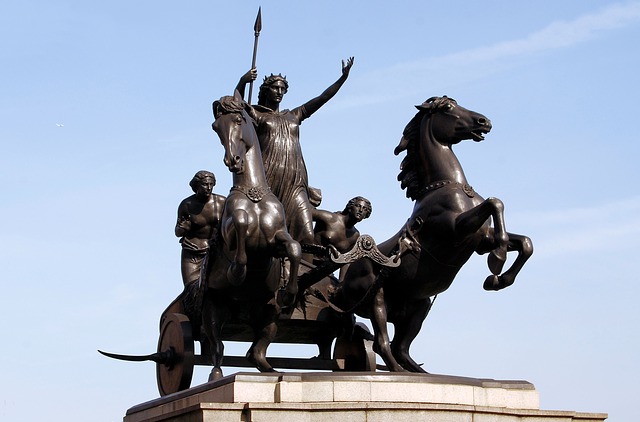By Tim Lambert
Celtic Warfare
About 650 BC the Celts introduced iron into Britain and they made the first swords.
Warfare was common during the Iron Age and many hill forts (fortified settlements) were built at that time. (Although there were also many open villages and farms). The Celts fought from horses or light wooden chariots. They threw spears and fought with swords. The Celts had wooden shields and some wore chainmail.
Celtic Society
Most of the Celts were farmers although were also many skilled craftsmen. Some Celts were blacksmiths (working with iron), bronze smiths, carpenters, leather workers, and potters. (The potter’s wheel was introduced into Britain c.150 BC). Celtic craftsmen also made elaborate jewelry of gold and precious stones. Furthermore, objects like swords and shields were often finely decorated. The Celts decorated metal goods with enamel. The Celts also knew how to make glass and they made glass beads.
At the top of Celtic society was a class of nobles headed by a king or chieftain. Below them were the craftsmen (of whom metalworkers were the most important). Then came the farmers who provided the food supply and also fought for the chief.
However, the Celts were divided into tribes. There was no political unity among them and a great deal of fighting.
The Celts grew crops in rectangular fields. They raised pigs, sheep, and cattle. They stored grain in pits lined with stone or wicker and sealed with clay. The Celts also brewed beer from barley.
Trade with Europe was common. Metals like copper, tin, iron, and lead were exported from England. Wool, cloth, skins, and grain were also exported. Luxury goods like fine pottery and expensive metal goods were imported from Europe. At first, the Celts used iron bars as a form of currency but by about 50 BC they were using gold coins.
Celtic Homes
The Celts lived in roundhouses. They were built around a central pole with horizontal poles radiating outwards from it. They rested on vertical poles. Walls were of wattle and daub and roofs were thatched. Around the walls inside the huts were benches, which also doubled up as beds. The Celts also used low tables.
Celtic Clothes
Celtic men wore tunics and trousers and women wore long dresses and mantles. They used bronze mirrors. Women wore belts around their dresses made of cloth, leather, or bronze rings. Celtic men soaked their hair in lime water to make it stand up straight. They wore mustaches but not beards. Wealthy Celts wore gold ornaments around their necks called torcs or torques.
The Celts made dyes from plants, woad, for blue, madder, for red, and weld for yellow.

Celtic Games
For amusement Celts played board games. They were also very fond of music and played flutes and lyres. In good weather, they held horse or chariot races. The Celts also enjoyed hunting wild boars on horseback.
Celtic Religion
The Celts had priests called Druids. The Druids were very important in Celtic society. As well as being priests they were scholars, judges, and advisers to the kings. The Celts were polytheists (they worshiped many gods and goddesses). They did not build temples but instead worshipped at natural sites such as groves of trees, springs, rivers, and lakes. Sometimes the Celts sacrificed valuable goods by throwing them into lakes and rivers.
In Celtic times the old practice of building barrows to bury the dead died out. Instead, people were interned in individual graves. They were still buried with grave goods showing the Celts had a strong belief in an afterlife. They believed that when you died your spirit went to a place called the other world. The Romans claimed the Druids practiced human sacrifice but this claim is doubtful.
The main Celtic festivals were Imbolc at the beginning of February at the start of the lambing season, Beltane at the beginning of May, when cattle were sent out to graze in the fields after being kept indoors and fed on hay during the Winter, Lughnasadh in August when the crops were growing ripe and Samhain at the beginning of November. That was the time when animals were brought in from the fields for the Winter. The Celts could not grow enough hay to feed them all so those not needed for breeding were slaughtered.

Although the Romans regarded the Celts as barbarians they created a sophisticated and advanced society. Women certainly had more freedom than in Roman society and Celtic craftsmen were superb.